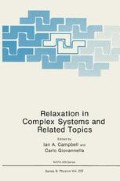Abstract
The disordered and frustrated XY-model is investigated to model weakly coupled superconducting grains in a magnetic field. We discuss its glassy features and relate them to high-T c superconductors. Monte-Carlo results are also presented, providing hints on the type of relaxational behavior of the magnetization and the magnetic memory effect known from spin glasses.
Access this chapter
Tax calculation will be finalised at checkout
Purchases are for personal use only
Preview
Unable to display preview. Download preview PDF.
References
K.A. Müller, M. Takashige, and J.G. Bednorz, Flux Trapping and Superconductive Glass State in La 2CuO4-y: Ba, Phys. Rev. Lett. 58: 1143 (1987).
I. Morgenstern, K.A. Müller, and J.G. Bednorz, Numerical Simulations of a High-Tc-Superconductive Glass Model, Z. Phys. B69: 33 (1987).
Y. Yeshurun and A.P. Malozemoff, Giant Flux Creep and Irreversibility in an Y-Ba-Cu-O Crystal: An Alternative to the Superconducting-Glass Model, Phys. Rev. Lett. 60: 2202 (1988).
C. Rossel, Y. Maeno, and I. Morgenstern, Memory Effects in a Superconducting Y-Ba-Cu-O Single Crystal: A Similarity to Spin-Glasses, Phys. Rev. Lett. 62: 681 (1989).
L. Lundgren, P. Nordblad and L. Sandlund, Memory Behaviour of the Spin Glass Relaxation, Europhys. Lett. 1: 529 (1986).
C. Ebner and D. Stroud, Diamagnetic susceptibility of superconducting clusters: Spin-glass behavior, Phys. Rev. B31: 165 (1985).
This formula can be derived from the supercurrents circulating in a network of Josephson junctions which is a physical realization of a frustrated XY-model.
M. Vanhimbeeck, R. Hetzel, unpublished work.
I. Morgenstern, (Spin) Glass Behavior in High-T, Superconductors, in: Proc. of the 16th Course “Earlier and Recent Aspects of Superconductivity” of the Int. School of Materials Science and Technology, Erice, July 4–16, 1989 (Springer-Verlag).
Author information
Authors and Affiliations
Editor information
Editors and Affiliations
Rights and permissions
Copyright information
© 1990 Springer Science+Business Media New York
About this chapter
Cite this chapter
Hetzel, R., Morgenstern, I. (1990). Numerical Simulation of the Magnetic Relaxation in Superconducting Systems. In: Campbell, I.A., Giovannella, C. (eds) Relaxation in Complex Systems and Related Topics. NATO ASI Series, vol 222. Springer, Boston, MA. https://doi.org/10.1007/978-1-4899-2136-9_18
Download citation
DOI: https://doi.org/10.1007/978-1-4899-2136-9_18
Publisher Name: Springer, Boston, MA
Print ISBN: 978-1-4899-2138-3
Online ISBN: 978-1-4899-2136-9
eBook Packages: Springer Book Archive

